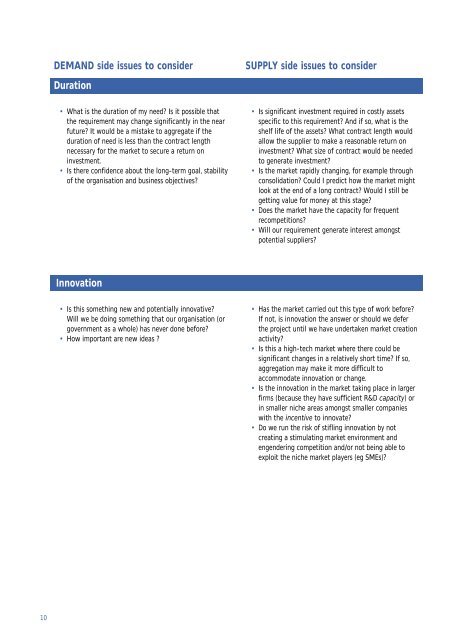Aggregation: Is bigger always better? - Eupian
Aggregation: Is bigger always better? - Eupian
Aggregation: Is bigger always better? - Eupian
You also want an ePaper? Increase the reach of your titles
YUMPU automatically turns print PDFs into web optimized ePapers that Google loves.
DEMAND side issues to considerDurationSUPPLY side issues to consider• What is the duration of my need? <strong>Is</strong> it possible thatthe requirement may change significantly in the nearfuture? It would be a mistake to aggregate if theduration of need is less than the contract lengthnecessary for the market to secure a return oninvestment.• <strong>Is</strong> there confidence about the long-term goal, stabilityof the organisation and business objectives?• <strong>Is</strong> significant investment required in costly assetsspecific to this requirement? And if so, what is theshelf life of the assets? What contract length wouldallow the supplier to make a reasonable return oninvestment? What size of contract would be neededto generate investment?• <strong>Is</strong> the market rapidly changing, for example throughconsolidation? Could I predict how the market mightlook at the end of a long contract? Would I still begetting value for money at this stage?• Does the market have the capacity for frequentrecompetitions?• Will our requirement generate interest amongstpotential suppliers?Innovation• <strong>Is</strong> this something new and potentially innovative?Will we be doing something that our organisation (orgovernment as a whole) has never done before?• How important are new ideas ?• Has the market carried out this type of work before?If not, is innovation the answer or should we deferthe project until we have undertaken market creationactivity?• <strong>Is</strong> this a high-tech market where there could besignificant changes in a relatively short time? If so,aggregation may make it more difficult toaccommodate innovation or change.• <strong>Is</strong> the innovation in the market taking place in largerfirms (because they have sufficient R&D capacity) orin smaller niche areas amongst smaller companieswith the incentive to innovate?• Do we run the risk of stifling innovation by notcreating a stimulating market environment andengendering competition and/or not being able toexploit the niche market players (eg SMEs)?10

















